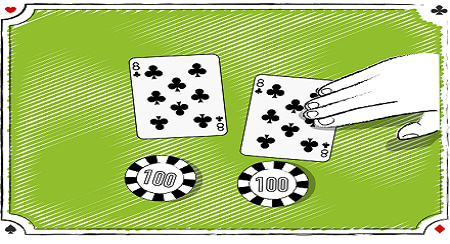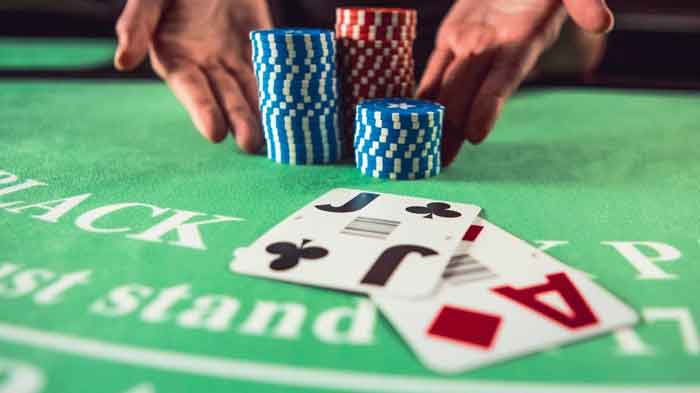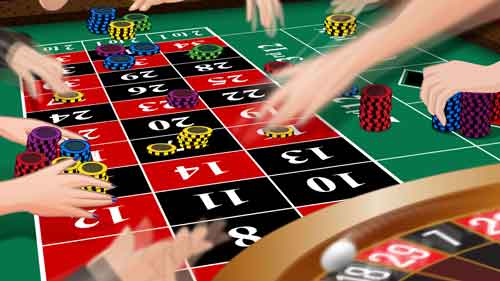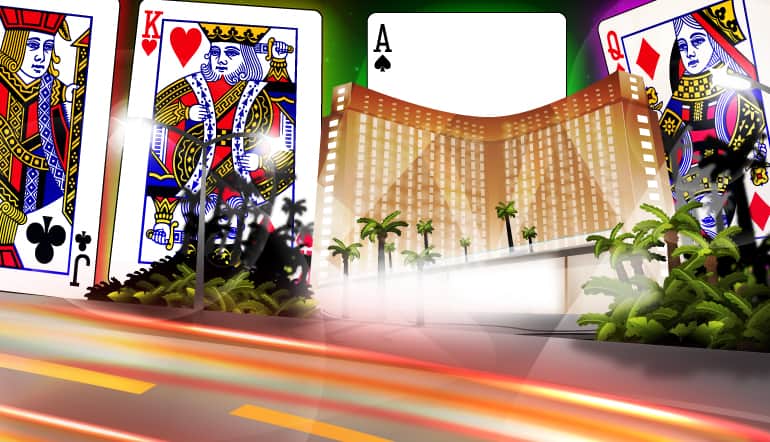Blackjack rules are considered as a bit complicated, but this article will clearly explain to you the rules of the game. This casino card game boasts a fascinating history and a global player base. The eponymous title came to be when the game of 21 arrived on America's shores. Back then, gambling venues needed to promote their casino games to players with all sorts of enticements.
With 21, the gambling halls promised big payouts if a Jack of Clubs or a Jack of Spades was dealt with players holding an Ace of Spades. The name stuck: Blackjack. It comes as no surprise that blackjack is the world's most popular casino card game.
Before we go any further, it's important to dispel the greatest myth about blackjack: The objective of the game is not to hit 21. Your goal is simply to beat the dealer's hand total without exceeding 21. Given this slice of trivia, you can confidently go about compiling the strongest possible hand against the dealer.
In blackjack, players don't compete against one another. You simply have to play your A-game against the blackjack dealer a.k.a. the house. Now that we've covered the basics, it's time to get into the nuts and bolts of the game.

SOME BASIC RULES: BLACKJACK CARD VALUES AND BLACKJACK CARD WORTH
Blackjack can be played with a single deck of cards, or multiple decks of cards, depending on the specific variant of the game. Blackjack goes by many different names, including 21, Vingt-et-Un, and Pontoon. This centuries-old casino game dates back to the 1760s in France.
Blackjack goes by many different names, including 21, Vingt-et-Un, and Pontoon. This centuries-old casino game dates back to the 1760s in France.
It was played by French nobility and aristocracy, ultimately breaking through into the mainstream for everyone to enjoy. Blackjack is universally played and enjoyed by millions of people. Whether you're playing at home, or at a casino, the game is governed by a unique set of rules.
The blackjack dealer, or croupier, is responsible for running the games. This includes shuffling the cards, dealing the cards, and taking care of all betting activity. The 52-card deck contains four suits (diamonds, hearts, spades, and clubs).
Each suit features cards Ace, 2, 3, 4, 5, 6, 7, 8, 9, 10, Jack, Queen, King. There are no jokers in blackjack. With the exception of the Ace which can assume a value of 1 or 11, cards ranked 2 – 10 have their nominal value, while Jack, Queen, and King assume a value of 10.
Blackjack card values are universally true, regardless of the variant you are playing. Recall that multiple decks of cards are used in blackjack games. Many blackjack casinos use 6 decks of cards, containing 312 cards in total. The blackjack dealer deals cards from a box known as a ‘shoe’, one at a time. Cards are dealt to the dealer and player in turn.
HOW DOES A GAME OF BLACKJACK BEGIN?
Blackjack is a betting game. This means that each of the players at the table must place a bet to buy in to the game. Betting takes place before cards are dealt to players. All players at the table will purchase chips which are then used to bet with.
Depending on where you play, it is possible to play low-limit blackjack games and high-limit blackjack games. Experts advise players to play within their means, to cautiously guard their budget, and only to gamble with money that is not required for other purposes.
After every game of blackjack, the cards are shuffled to ensure the randomness of outcomes. In online blackjack, RNGs (random number generators) replace automatic card shuffling machines.
FAST FACT - INSURANCE BETS IN BLACKJACK
In classic blackjack games, between 1 and 8 decks of cards may be used. Once the bets have been placed, the dealer will hand out 2 cards to each player at the table and 2 cards go to the dealer. Only one of the dealer's cards is face-up, and the other is face down.
All of the player's cards are dealt face up for obvious reasons. Some interesting rules come into play if the dealer's face-up card is an Ace. At this point, the player will be offered the option of an insurance bet. This blackjack side bet pays 2:1 if the dealer's face-down card (hole card) is a 10-value card. Blackjack experts do not recommend taking the insurance bet, since the odds are not in your favour. Consider the following scenario:
Player hand: 6 of hearts, 8 of clubs
Dealer hand: Ace of spades you are offered The Insurance Bet
If you are betting $50 on the main game, the insurance side bet is an additional bet which requires you to bet $25 more. It only pays out if the dealer has blackjack. Then, you will win 2:1, which is $50. If the dealer doesn't have blackjack, you will lose your $25 bet.
In this case, you may still win the hand with your main bet, but you will lose the insurance bet. The odds of the dealer having a blackjack (10-value card) with an Ace up-card are 9:4. For every 13 bets you place at $25 a pop, you will lose 9 of them and win 4 of them. Since you double your money on wins, you’d come out with (9 x $25) - (4 x $50) = $25 in losses over the long-term.
BLACKJACK BETTING RULES
Blackjack blends skilled play and good fortune. Those who have mastered the game routinely perform well, indicating that a definite  edge exists for players with an in-depth knowledge of the rules. Over the years, many blackjack strategy guides have been written, extolling the virtues of card counting systems and strategy charts.
edge exists for players with an in-depth knowledge of the rules. Over the years, many blackjack strategy guides have been written, extolling the virtues of card counting systems and strategy charts.
For the everyday player, such techniques may prove a little overwhelming. Basic blackjack strategy is where it all begins. Provided you know the value of the cards, and the rules of the table, you're halfway there.
The rules of the table will determine the types of bets you can place, and the payouts you will receive. Does the table pay 3:2 on blackjack, or does it pay 6:5 on blackjack? The difference is substantial as you are about to see.
Let's assume you place a $100 bet and you are dealt blackjack. At a 3:2 table, your blackjack pays $150. That means your profit is $50. At a 6:5 table, blackjack pays $120. That means your profit is $20. It's a big difference, especially when you're placing multiple bets during your gambling sessions.
You're probably wondering whether it is more advantageous to you, or the casino, if more decks of cards are in play. Recall that a game of blackjack can be played with 1 deck of cards, or up to 8 decks of cards.
As a card counter, you are better served with fewer decks in play. Why? It's much easier to keep a running count. Casinos routinely use between 6 and 8 decks of cards for precisely that reason. They don't want mathematically-minded players to gain a competitive edge over the dealer at any time.
There are many instances of advantage players over the years, notably with the MIT teams at casinos around the world. Card counting is perhaps the most widely popularized strategy used by blackjack players. At its heart, counting cards is about tracking high-value cards, and low-value cards.
EXAMPLE OF BLACKJACK CARD COUNTING:
• 10, Jack, Queen, King, Ace > -1
• 2, 3, 4, 5, 6 > +1
• 7, 8, 9 > 0
Every time the dealer deals a card that falls into one of the three categories, 1 is either added or subtracted to the running count. A high positive number is indicative of many 10-value cards remaining in the deck. A low number is indicative of many low-value cards remaining in the deck. Betting decisions are based on the likelihood of a high or low-value card being dealt with next.
Note that the running count changes with every card that is dealt with. If the running count is a high positive value, players will bet big. If the running count is a negative value, players will bet less. Every time the deck is shuffled, the count reverts back to 0.
BACK TO BLACKJACK BASICS: BETTING OPTIONS WITH YOUR CARDS
After your cards have been dealt to you, the dealer will ask whether you wish to hit, stand, double, split, or surrender. Your decision is based on the cards you are holding, and the dealer’s up card. A running count is useful, but not necessary in this situation.
BLACKJACK RULES FOR HITTING

Hit – If you want to take an additional card, you hit. The dealer will hand you another card. You can continue hitting until you are satisfied with your hand total, or until you bust (exceed 21).
BLACKJACK RULES FOR STANDING

Stand – If you are satisfied with your hand and you do not wish to take any additional cards, you simply stand. The dealer may take additional cards, based on the rules in play. Typically, the blackjack dealer will draw to 16 and stand on all 17s (hard and soft).
BLACKJACK RULES FOR DOUBLING DOWN

Double – The act of doubling down in blackjack is often used by players who want to take just 1 more card and double their bet in the process. This action can significantly boost your winnings, or increase your losses. With the double option, you're only allowed to take 1 more card – no more.
You can multiply your winnings or your losses. It's important to carefully assess your chances of winning before you take the double option. Experts advise players to take the dealer’s upcard into consideration when using this play.
BLACKJACK RULES FOR SPLITTING PAIRS

Splitting pairs – Players are always trying to find inventive ways of whittling down the casino’s edge in blackjack. Splitting is one technique which can work in your favor. You can split when your first two cards are identical, such as a pair of 7s, or a pair of Kings, etc.
There are hard and fast rules for pairs that you should always split, including a pair of 8s and a pair of Aces. Why. 8s? Because it's possible that you will end up with a hand valued at 18 which has a winning chance in blackjack. When you split, you are also increasing your bets so think carefully before splitting pairs.
In certain circumstances, the casino will allow you to re-split if you form a pair from your split hand. Under the right conditions, splitting can certainly be beneficial. A pair of Aces are always split, while a pair of 10-value cards are typically never split.
BLACKJACK RULES FOR SURRENDER

Surrender – The Surrender option (when available) allows you to forfeit half of your bet to the casino and retain half of the bet for yourself. Note that you will not play the hand. The Surrender option is only available on the first two cards.
BLACKJACK RULES FOR A PUSH
Push - Sometimes, neither the player nor the dealer will win a game. If you have the same value hand as the dealer, the result is known as a push, or a tie. Your bet will be returned to you.
BLACKJACK RULES FOR THE DEALER
When players have completed all these actions, the dealer will reveal the hole card. Recall that only 1 of the dealer’s 2 cards is visible to players. It's worth pointing out that the blackjack dealer always has an advantage over the player because the player acts first. In other words, players choose actions until they are satisfied with their hand total, or until they bust. The dealer does not have to act while all of this is taking place.
When it is the dealer's turn to act, there are rules in place to determine what the dealer is allowed to do. For example, the table rules may state that the dealer draws to 16 and stands on all 17s. If the dealer’s hand total exceeds 21, the dealer busts and players who have not bust will win.
Sometimes, neither the dealer nor the player busts. In situations like this, the highest hand total under 21 wins. A straight win pays even money, while blackjack pays either 3:2, or 6:5. The latter is known as a short-paying blackjack. If possible, always pick blackjack tables which payout 3:2.
Even though the dealer is last to act, there are still rules that must be followed. Casinos put these rules into play to protect their own interests, but if you use perfect blackjack strategy this is the only game where the player can substantially reduce the house edge to around 0.5%.
Like any other casino game, the built-in house edge is designed to favour the casino. In the case of blackjack, the fact that the dealer acts last makes a big difference. It's worth explaining the difference between a soft 17 and a hard 17. Recall Aces can assume a value of 1 or 11 depending on the strength of the hand. A soft 17 is one which contains an ‘Ace’ that counts as 11, and the other cards sum to 6. With a hard 17, the ‘Ace’ can only assume a value of 1.
BLACKJACK RULES AT THE CASINO
Blackjack is the #1 most popular casino card game. This is true at casinos across the United States, and at many casinos around the world. Since there are so many different types of blackjack games available, the rules depend on the games that you are playing.
Popular blackjack variants include Classic Blackjack, American Blackjack, European Blackjack, Blackjack Switch Spanish 21, 21+3, Golden 21, Atlantic City Multihand Blackjack, Vegas Strip Blackjack, Perfect Pairs Blackjack, Double Exposure Blackjack, Caribbean Blackjack, and many more. Each game has different requirements and a different set of rules to play by.
Vegas Strip Blackjack – this game is played with 4 decks of cards and players are allowed to split a pair of Aces once. Players can double on any 2 cards. If a player forms a hand total of 21 after splitting, that is not considered blackjack.
Perfect Pairs Blackjack – players have the option to make an additional side bet known as a Perfect Pairs bet. In this game, you can win if your first two cards form a pair. The winnings are bigger if these pairs are the same color, and bigger yet if they are identical suits.
Double Exposure Blackjack – in this game, both the dealer’s cards are dealt face up. The players must pay a price for having such an advantage, and this is reflected in the payouts with different combinations. Blackjack pays 1:1, and when players and dealers have the same value hand, the player loses. Players can only split their cards once in this version of the game.
Blackjack Switch – with Blackjack Switch, you are allowed to play two combinations of cards with two cards at the same time. Since you have two hands in play, you can switch cards between those hands. If the dealer’s hand total is 22, the player’s bet is returned. Blackjack pays 1:1 (even money), and not 3:2 as in standard games.
As you can tell from the different variants, casinos are willing to change the rules of blackjack to allow for greater variety. Of course, there is give-and-take since the payout odds will change accordingly.
WHAT ARE THE BLACKJACK RULES IN VEGAS?
Vegas Strip Blackjack, Vegas Rules, or American 21 were the standard for many casinos offering blackjack games. This traditional set of rules has all but disappeared over the years, except in VIP blackjack games, and at high-roller blackjack tables.
Fortunately, you can still enjoy Vegas-style blackjack rules at many online casinos today, including, off course, our online casino site. Vegas Strip Blackjack features 4 decks of cards. The goal is to beat the dealer's hand total without exceeding 21. There are specific rules in play with Vegas Strip Blackjack, including the following:
• Aces can only be split once
• Blackjack payouts are 3:2, or 6:5
• Players can split any 10-value cards
• Only one card can be used to split Aces
• Players are allowed to split up to 4 hands
• The Dealer is allowed to peek for blackjack
• The dealer must stand on soft 17s (Ace valued at 11)
• If players form 21 off split Aces, it is not considered blackjack
• Players can double on any 2 initial cards dealt and after splitting
There is another popular blackjack variant in Las Vegas known as Vegas Downtown Blackjack. In this game, the dealer must hit on a soft 17, and the game is only played with 2 decks of cards.
BLACKJACK RULES CHART
A Blackjack Strategy Chart, otherwise known as a Blackjack Rules Chart is designed to teach you when to hit or stand when to split pairs, when to surrender your cards, and when to double down. It is part of an overall basic strategy to get you started, but not to guarantee winnings. Many other techniques, systems and betting practices must be employed to successfully reduce the house edge and win consistently.
Players will do well to commit blackjack strategy charts to memory, to position themselves better for victory. Blackjack rules charts are generic and must be adapted to the specific blackjack games you are playing. Your performance will improve with practice. There are many rules in these charts, including the following:
• Never split a pair of Tens, but always split a pair of Aces
• Always split a pair of 8s, and follow the rules for 2s, 3s, 4s, 5s, 6s and 7s
• If the dealer’s up card is a 10, and your total is 15, surrender
• If the dealer’s up card is 9-Ace, and your hand total is 16, surrender
• Always stand on a soft 20, and always stand on a hard 17
• Always hit on 8 and always double on 11
A blackjack rules chart reveals hand totals for the player in the vertical column, and the dealer’s up card in the horizontal column. With each card, there is an action that the player must take. Actions include the following: Hit, Stand, Double if Allowed, Otherwise Hit, Double if Allowed, Otherwise Stand, Don't Split the Pair, Split the Pair, Split Only if Double and Splitting is Offered.
Blackjack rules charts provide hard totals and soft totals, as well as pair splitting options.
BLACKJACK RULES FOR ACES
The only card in the deck which is capable of assuming two unique values is the Ace. These cards can hold a value of 1 or 11, depending on the other cards in a player's hand.
Let's assume that you have been dealt with the following two cards upfront: 7 of diamonds + 9 of hearts. In this situation, you would likely double according to the blackjack strategy charts. If the card you are dealt with is an Ace, your hand total is 17. Since the Ace counts as 1, it is a hard 17. The Ace cannot assume a value of 11, because you will bust.
Now let us look at the case of a soft 17. In this scenario, the value of your Ace is 11. If your other cards add up to 6 (2+4, 3+3), your Ace counts as 11 and you have a soft 17. Of course, you can decide to hit again and draw a 10, Jack, Queen or King, to have a hand total of 17. If there is flexibility with respect to the value your Ace can assume, it is a soft hand. If not, it's a hard hand total.
Study up on these blackjack rules and you will definitely improve your game over time. Blackjack is the only casino game where players can significantly improve their winning chances against the dealer. In some cases, it is possible to entirely wipe out the house edge, if you're good enough!















